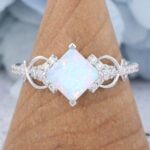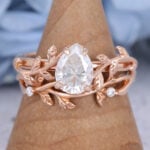16 Must-Know Beautiful Purple Gemstones and Crystals
Purple gemstones are often seen as symbols of romance and love, making them especially popular among women who are drawn to this elegant hue. While amethyst is the most well-known purple gemstone, there are many other captivating purple precious stones, semi-precious gemstones, and crystals worth discovering. In this guide, we’ll explore a list of 16 stunning purple gemstones and crystals you should know.
Purple Gemstones
Purple Sapphire: A Rare And Highly Durable Purple Corundum
Sapphires come in many colors, and purple sapphires are a special kind, which is a precious stone. Purple sapphires are actually corundum, which is mainly composed of aluminum oxide. It has a Mohs hardness of 9, which is harder and more wear-resistant than all gemstones except diamonds. The colors of the purple gemstones mainly come from trace amounts of chromium and iron in the crystals, and the ratio of the two determines the final depth of purple.
Some purple sapphires may show subtle color-changing effects under different light. Natural high-quality purple sapphires are mainly produced in Sri Lanka and Madagascar, but because of their scarcity, they are regarded as one of the rarest and most precious purple rare gemstones.
Purple Spinel: Known For Vivid Color And Excellent Clarity
Purple spinel is a natural purple colored gemstone with magnesium aluminum oxide as the main component. It belongs to the spinel family. The purple hue comes from trace amounts of iron, chromium or manganese. The crystal structure of purple spinel is an isometric crystal system, usually forming octahedral crystals with good transparency and luster. It is a hard purple stone with a Mohs hardness of 8.
Some purple spinels are violet gemstones, some are reddish purple gemstones, some are light purple stones and some are dark purple precious stones. High-quality purple spinel is mainly produced in Myanmar and Sri Lanka. Spinel has long been mistaken as a alternative for ruby. It has not become an independent natural gemstone until recent decades and is widely used in high-end jewelry because of its rich colors, pure crystals and strong fire.
Tanzanite: A Rare Gem With Striking Blue-Violet Hues
Tanzanite is a bluish purple precious gemstone, which is composed of a variant of Zoisite, and its main component is calcium aluminum silicate. Tanzanite has a unique Pleochroism, and blue, purple and even burgundy tones can be seen from different angles. The Mohs hardness of this purple gemstone is 6.5–7. It needs to avoid heavy blows and scratches when worn daily, but it is still very durable and is made into Tanzanite rings, pendants and other jewelry.
Natural Tanzanite is mostly brown or yellowish brown, and almost all gem-grade Tanzanite is heated to stabilize its bright blue-purple color. Tanzanite is known as “more rare purple gemstones than diamonds” because it is mined in only one mining area in the world and has limited resources. Its charming blue-purple color and scarcity make it one of the most popular precious gemstones in modern times and one of the birthstones for December.
Purple Garnet: Valued For Its Deep And Rich Purple Tones
Garnet is often known for its red variety. However, purple garnet is a rare variety in the garnet family. It is mostly a mixture of Almandine and Pyrope, and occasionally contains Manganese garnet. Different proportions of the ingredients will result in different colors from deep purple to reddish purple. The Mohs hardness of purple garnet also reaches 7-7.5, which is suitable for daily jewelry.
Purple garnet has a fire color comparable to ruby, and is a purple stone with sparkles. These charming purple gemstones are mainly produced in Mozambique, Tanzania, etc. Pure purple garnet is extremely rare, so its market value and investment value are relatively high.
Purple Tourmaline: Noted For Its Vibrant Lavender-Pink Shades
Purple Tourmaline, also called rubellite, is known for its vibrant lavender-pink to deep magenta shades. It has a hardness of 7 to 7.5 on the Mohs scale, making it durable for everyday wear. Among the names of purple gemstones, it stands out for its rich and varied tones.
This gemstone holds a respected place in the jewelry world, valued for both beauty and toughness. Major sources of purple tourmaline include Brazil, Mozambique, and Afghanistan, where high-quality stones are mined.
Kunzite: Recognized For Its Large Crystals And Pleochroism
Kunzite belongs to the spodumene family and is a purple variant, mainly composed of lithium aluminum silicate. Its purple color comes from the trace amount of manganese in the gemstone, so it is often called lilac gemstones. Due to differences in color and transparency, some Kunzites present a deeper violet color (violet colored crystals). Kunzite has a hardness between 6.5 and 7, and its structure is strong and stable, but long-term exposure to strong light may cause the color to fade, so special care should be taken when wearing it.
Kunzite symbolizes love, emotional balance and inner peace. Because its high refractive index makes the reflected light more dazzling, it is deeply loved by young consumers, especially women. It is often used as the main stone of jewelry such as rings, showing a unique charm.
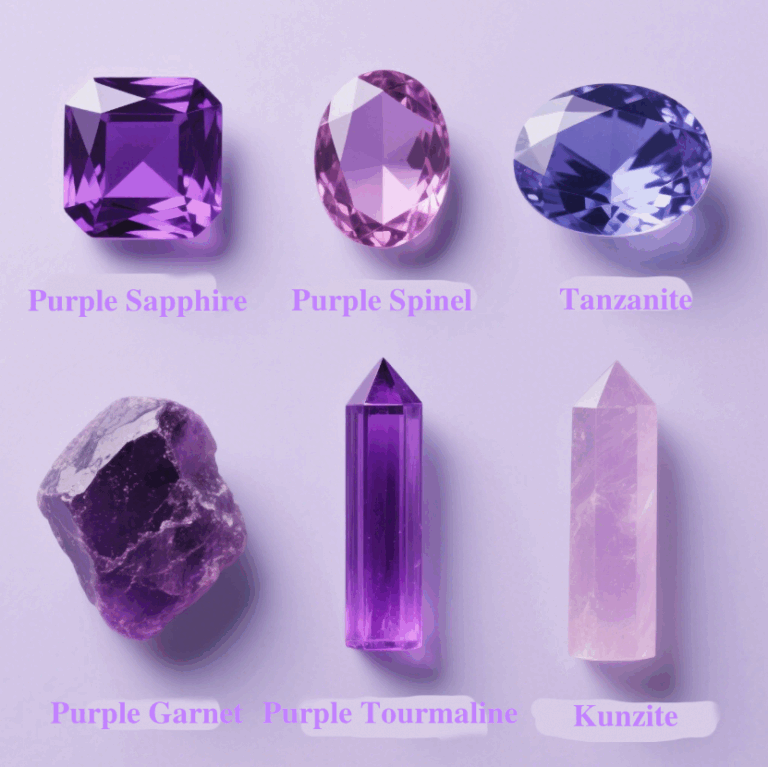
Purple Semi-Precious Gemstones
Amethyst: The Most Widely Recognized Purple Quartz
Among all types of purple gemstones, Amethyst is undoubtedly the most well-known and widely used stone with purple crystals. This purple precious stone belongs to the quartz family and is a typical clear and purple crystal. Its unique purple color comes from the internal trace iron elements and natural radiation, which makes its color extend from soft light purple to rich dark purple, making it a very attractive light purple to deep purple gemstone.
As a classic solid purple stone, amethyst is usually transparent to translucent, with bright luster and good durability. It has a Mohs hardness of 7 and is not easy to scratch. It is very suitable for daily wear, which is both practical and beautiful.
The reason why amethyst is so popular is inseparable from the symbolic meaning it carries. It is regarded as a spiritual gemstone that can help enhance wisdom, intuition and spiritual awakening. At the same time, it is also the purple birthstone of February, which is believed to bring good luck and protection to those born in February.
Lolite: Famous For Its Strong Pleochroism Effect
Lolite, also known as Water Sapphire, is a silicate mineral, but it is not a true blue gemstone, but a translucent purple stone with a dark purple or violet or even brown tone, belonging to the dark purple semi precious stone. Iolite has a strong Pleochroism, and this color change is related to the optical birefringence effect in the crystal structure. It has a hardness of 7-7.5 and can be used for daily wear.
Lolite is often used as a meditation stone, symbolizing inner truth, spiritual insight and emotional balance. The Iolite currently on the market is mainly produced in India and Sri Lanka.
Lavender Jade: Appreciated For Its Smooth Texture And Subtle Color
Lavender Jade is a translucent light purple precious stone, belonging to the jadeite of pyroxene minerals. Lavender Jade is a relatively hard purple gemstone (6.5 – 7). Some high-quality lavender jade can reach a transparency close to glass, but most of them are glutinous or bean-type, showing a soft and warm luster.
The value of natural Lavender Jade has been rising year by year in the auction market and collection circles in recent years. Myanmar is the main production area of this high-quality jade.
Charoite: Distinguished By Unique Swirling Lavender Patterns
The name of the purple semi precious stone comes from the Charo River in Russia, where it was first discovered. Charoites are semi-transparent to opaque purple gemstones ranging from light lavender to dark purple, even some purple and black crystals, usually with natural swirling, flowing or feathery textures.
Charoite has a unique satiny luster, sometimes with a cat’s eye effect or pearl luster, and a dreamy and soft visual effect. It is known as the “stone of soul purification” and “stone of transformation”, which helps to relieve fear, anxiety and negative energy. The Murun Mountains in Siberia, Russia is the only place where this purple gem is produced.
Sugilite: A Rare Deep Purple Stone Prized In Metaphysical Circles
Sugilite is a dark purple gemstone, and some raw stones may contain black, brown and other mineral impurities. The name of the purple jewelry comes from the geologist who first discovered this mineral in 1944. This opaque purple stone is slightly harder than Charoite (5.5-6.5), so be careful to avoid strong wear when wearing it.
Sugilite is considered the rarest purple gemstone because these purple gemstones are becoming increasingly scarce and prices continue to rise. The Wessels mine in South Africa is currently the main source of high-quality purple sugilite.
Lepidolite: A Lithium-Rich Mica Mineral With Soft Lilac Hues
Lepidolite is a light purple precious stone, also with dark purple and lavender purple tones. These purple gems are usually opaque to translucent with pearl luster, with a low Mohs hardness, and are not suitable for long-term wear.
Lepidolite is one of the most common “calming stones” in energy healing, which can heal emotions and stabilize the mind. Due to its low hardness, it is polished into pendants, bracelets, touch stones, and carved ornaments.
Purpurite: Noted For Its Bold Matte Purple Appearance
Purpurite is named for its bright purple color. It belongs to the phosphate mineral family and has a natural matte powdery texture on the surface, making it highly recognizable. These purple gemstones are opaque, with a Mohs hardness of about 4–4.5, slightly softer than amethyst, so they need to be carefully maintained. Although not suitable for daily wear, they are often used to make touch stones, carvings, etc.
Purpurite is a unique purple mineral that combines artistic visual impact and spiritual energy value. High-quality raw stones have deep color and no cracks, and have extremely high ornamental and collection value. Its main production area is Namibia, where resources are relatively abundant and the market price is relatively reasonable.
Stichtite: Characterized By Pastel Purple With Green Inclusions
Stichtite is a gemstone that is purple. Its purple color mainly comes from the magnesium-chromium minerals in it. It looks like green and purple crystals, with soft colors and rich layers. This gem has a soft texture and is often used to make pendants and bracelets.
Stichtite is mainly produced in Australia. It can symbolize harmony and balance. It is often used in meditation and energy healing to help release negative emotions and enhance inner peace.
Purple Agate: Known For Layered Patterns And Unique Purple Hues
Purple agate is a variety of agate in the quartz family. Due to its unique layered structure, purple agate looks like a purple and white gem. Purple agate has a high Mohs hardness (6.5–7) and is widely used to make rings, necklaces, bracelets, pendants and other accessories.
Purple agate symbolizes balance and stability, helps regulate emotions, and enhances inner peace and strength. It is regarded as a semi-rare gemstone and is mainly produced in Brazil and other places.
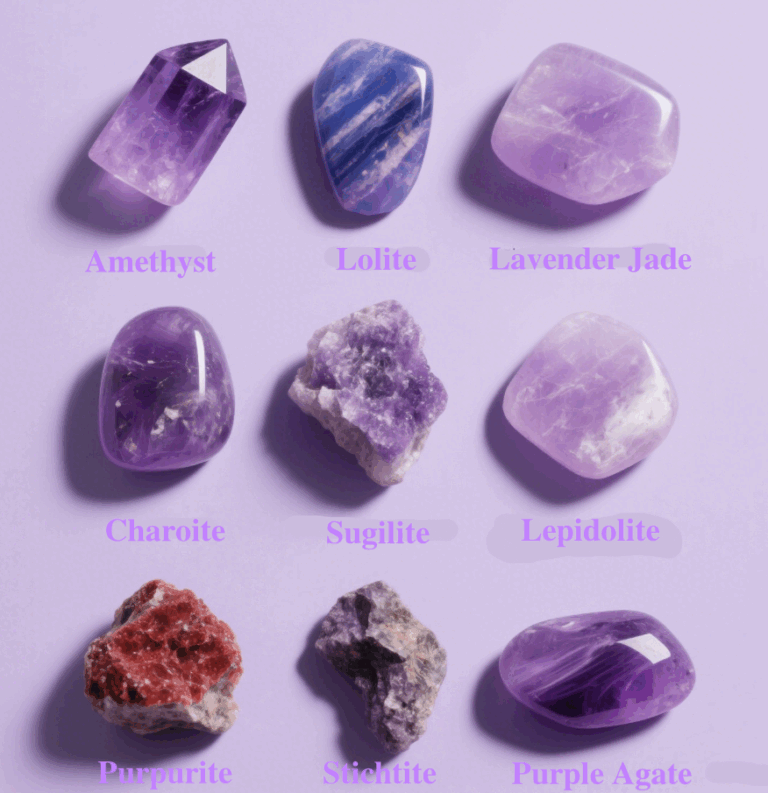
Purple Crystal
Fluorite (Purple): Known For Its Translucence And Color Zoning
Fluorite is often known as “natural colored crystal”. It is a halide mineral with fluorescent effect and multi-color band characteristics. It often shows obvious color zoning, usually purple and colorless, green, blue or white stripes are distributed alternately. The main component of purple fluorite is calcium fluoride, with a soft texture, ranging from light purple to dark purple, and a bright glass luster on the surface.
With its gorgeous color bands, transparent texture and good energy properties, Fluorite has become a popular gem variety in the field of collection and spirituality, and its main production area is China.
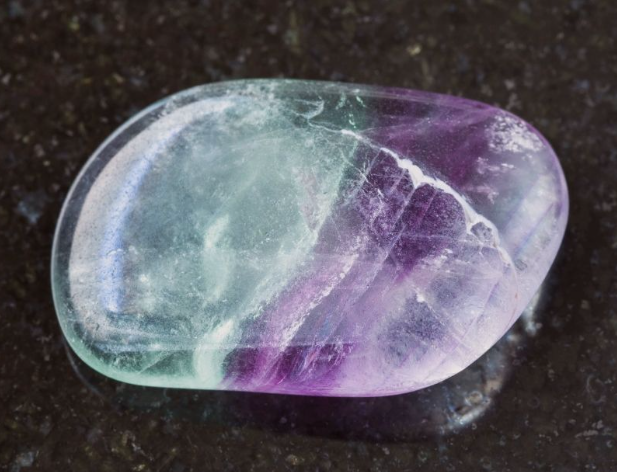
Conclusion
This article explores 16 stunning purple gemstones and crystals, highlighting their meanings, spiritual uses, and the different names of purple colors found in nature and mineralogy. Perfect for those interested in purple gemstones and meanings.
FAQs About Purple Gemstones and Crystals
Are purple gems more valuable than blue gems?
Not always. Value depends on rarity, clarity, and demand. While some purple gems like Alexandrite can be highly valuable, blue gems like Sapphire often command higher prices due to prestige.
What semi precious stones are purple?
Popular purple semi-precious stones include Amethyst, Lepidolite, Charoite, Fluorite, Purple Agate, and Sugilite.
What gemstone is purple color?
Amethyst is the most well-known purple gemstone, prized for its vibrant violet hue and widespread use in jewelry. And all the above gemstones mentioned in the article are purple.
What is a purple precious gemstone called?
The most recognized purple precious gemstone is Amethyst, once considered a precious stone historically.
What is a purple precious stone?
Amethyst is the classic purple precious stone, valued for its color and spiritual symbolism.
What do the purple crystals mean?
Purple crystals symbolize wisdom, peace, intuition, and spiritual growth. They’re often used in meditation and healing.


